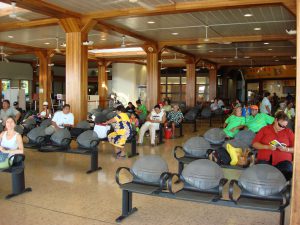Guatemalan Chicken Bus, Farming Town
Public transportation in Guatemala is an experience that everyone should have a chance to experience. In our rush to get to the orphanage we were volunteering at near Parramos we were anxious to get on a bus that would take us there. When asking a local where we could catch a bus to this little town he did not understand at first.
After a few tries and mentioning the name of another city further on the local person corrected me on the pronunciation of the little town we were headed to. “Para-Moose” he said with an expectant tone in his voice for me to repeat it back to him. Para-Moose I repeated back to him as I rolled the r’s. He pointed me in the direction we needed to go in and we were quickly on our way.
The first bus we saw that was pulling out was a red converted Blue Bird bus much like all the others. It was decorated with a variety of stripes and designs on the exterior. We were among the first to board the bus which was still parked. Within a minute it pulled out of the parking lot and we were on our way. We had 40 minutes to make the 20 minute trip so we felt confident that we had plenty of time.
We pulled out of the bus lot going 5 kilometers per hour. It was a turtle’s pace. Our driver was taking his time while his assistant, the money collector was hanging out the door yelling “Parrama, Parrama, Chima, Chima” which were the shortened versions of the two cities they were headed to. Only about 6 people were on the bus and the salesperson hanging out the door was obviously concerned that he needed a lot more people on his bus to make enough money for the trip to be worthwhile.
We bumped down the dusty parking lot until we reached the cobblestone streets of Antigua. We were going so slow that it took us 10 minutes to circle the block to pick up passengers. At a snails pace we continued on through the streets of Antigua gathering more and more passengers as the bus driver’s assistant hollered out its destinations. While this was all happening, nobody was asked for any money. It wasn’t until 20 minutes later that we finally had finished winding through Antigua’s streets before we really were on our way.
This is when the money collector came through the bus. My kids and I each paid our 30Q ($0.36) for the ride and silently sat at the front of the bus. By now each of the school bus bench seats had up to three people crammed onto them. I held on tightly to my waist pack which contained my wallet and change thanks to the advice of the lady at our hotel. “Be careful on crowded Chicken Buses” she explained in Spanish. “They are a common target for pickpockets”.
I could smell the dust of the road as we rolled along the highway that had patches of gravel and patches of paved road. At one point the only paved section was in the oncoming lane and so the driver took the liberty of using this stretch of road until a large truck started barreling towards us. Other riders were not saying much so the only sounds I could hear were from the rattling of the bus as we bumped down the highway and through small little concrete villages that occasionally lined the road.
As we approached Parramos villagers walked down the road with shovels, wheelbarrows and hoes in hand. In this agricultural area, villagers flagged down the bus from time to time when they needed a ride. Wherever a paying passenger was, the bus stopped. It was obvious that the longer the driver took on his route, the more fares he could collect from the extra people being squeezed onto the bus.
We finally reached the town square where we disembarked the bus and met up with our ride. He took us the last 3 kilometers to the Orphanage we would spend the next few days volunteering at. As we drove these last few kilometers I saw donkeys laidened down with bundles of sticks for firewood, old people with hoe’s over their shoulders and ladies pushing wheelbarrows. They were all headed for a day of work in the fields to make a small living off of the land.


